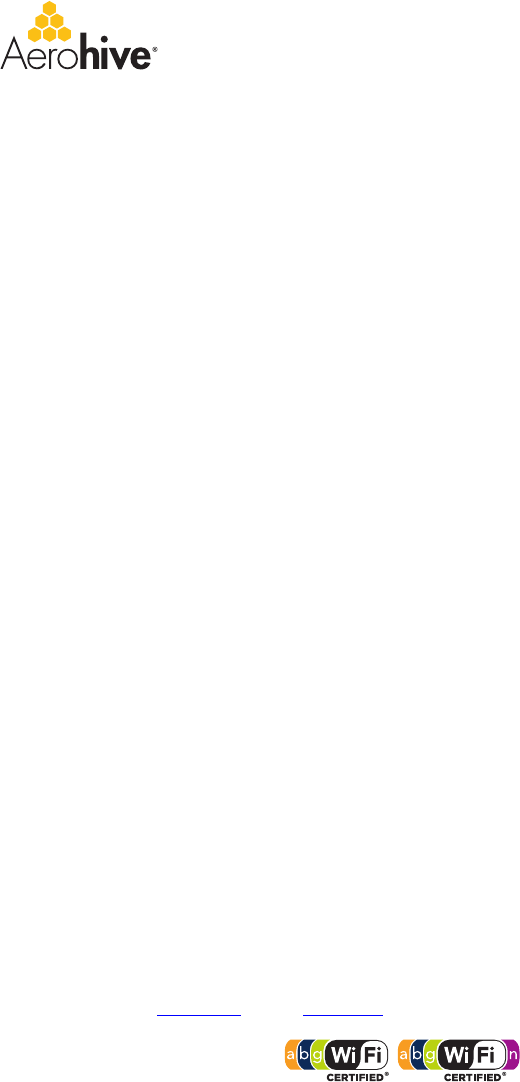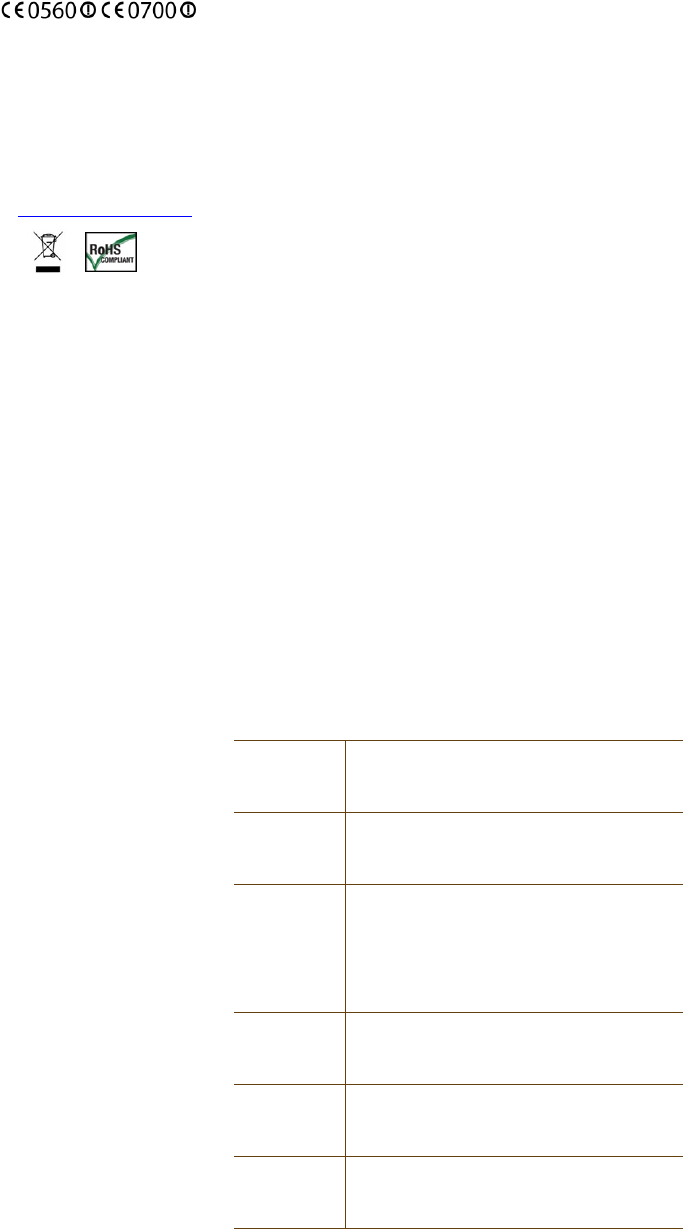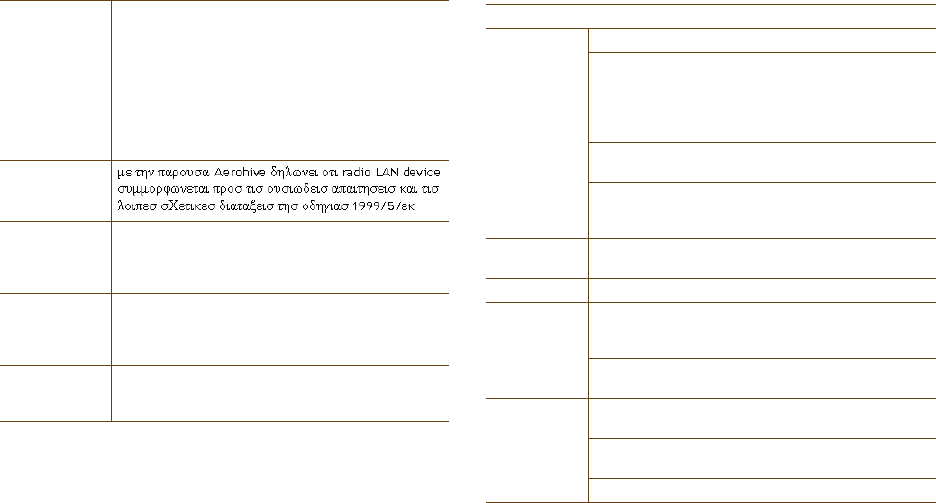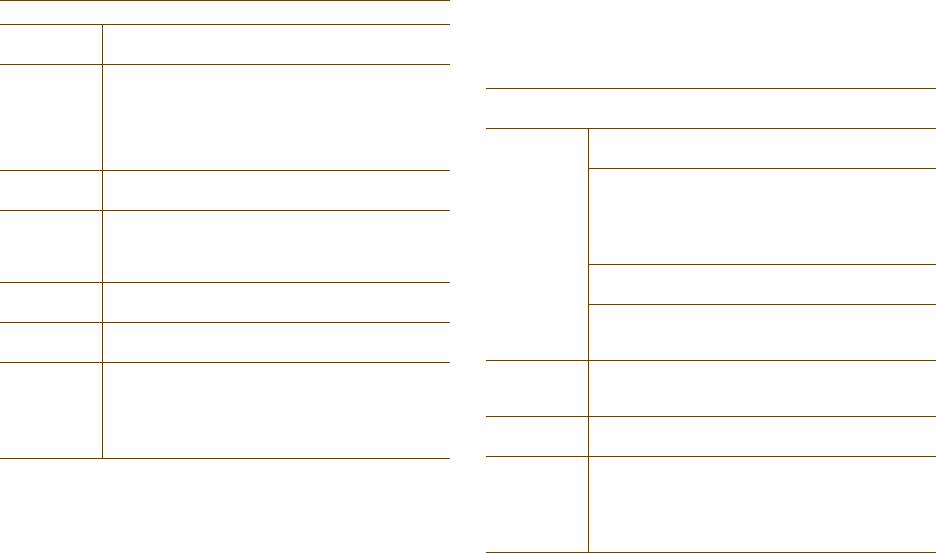Aerohive Networks HIVEAP320DFS 802.11a/b/g/n access point User Manual Aerohive HiveAP Compliance Information
Aerohive Networks, Inc. 802.11a/b/g/n access point Aerohive HiveAP Compliance Information
Contents
- 1. user manual
- 2. User manual
- 3. Manual
Manual

© 2010 Aerohive Networks, Inc. All rights reserved. 330033-03 Rev. A
Aerohive HiveAP Compliance Information
Federal Communication Commission Interference
Statement
Aerohive products that show an FCC identifier on the product label
(FCC ID: WBV-<model_name>) comply with part 15 of the FCC Rules
when operating under the following restrictions: (1) they do not cause
harmful interference, and (2) they must accept any RF interference
received, including interference that might cause an unwanted impact
on their operation.
This equipment has been tested and found to comply with the limits for
a Class B digital device, pursuant to Part 15 of the FCC Rules. These
limits are designed to provide reasonable protection against harmful
interference in a residential installation. This equipment generates,
uses and can radiate radio frequency energy and, if not installed and
used in accordance with the instructions, may cause harmful
interference to radio communications. However, there is no guarantee
that interference will not occur in a particular installation. If this
equipment does cause harmful interference to radio or television
reception, which can be determined by turning the equipment off and
on, the user is encouraged to try to correct the interference by one of
the following measures:
• Reorient or relocate the receiving antenna
• Increase the separation between the equipment and receiver
• Connect the equipment into an outlet on a circuit different from
that to which the receiver is connected
• Consult the dealer or an experienced radio/TV technician for help
FCC Caution: Any changes or modifications not expressly approved by
the party responsible for compliance could void the user's authority to
operate this equipment. This device complies with Part 15 of the FCC
Rules. Operation is subject to the following two conditions: (1) This
device may not cause harmful interference, and (2) this device must
accept any interference received, including interference that may
cause undesired operation.
In compliance with FCC Part 15 regulations, the HiveAP automatically
discontinues transmission if there is no valid information to transmit or
if there is an operational failure.
Important: FCC Regulatory Warnings Notice
This equipment is restricted to indoor use due to its operation in 5 GHz
frequencies, which are shared by mobile satellite systems and
government radar systems. The FCC requires that this product only be
used indoors to reduce the potential for harmful interference with co-
channel radar that might be operating in the 5.25-5.35 or 5.47-5.725
GHz frequency ranges in the same area. The conflicting activity of
radar stations and this device can cause interference or damage to each
other. In addition, this device has a radar detection function that might
interrupt normal operations when it detects a radar signal.
To reduce the risk of interference even further, installing this device
away from windows is recommended.
This equipment complies with the FCC DFS (Dynamic Frequency
Selection) rules documented in FCC 06-96 and KDB 443999. The 5 GHz
radio uses channels 36 to 48 (5.180 to 5.240 GHz) and channels 149 to
165 (5.725 to 5.825 GHz), as well as channels within the DFS operating
frequency ranges: 52 to 64 (5.25 to 5.35 GHz), 100 to 116 (5.47 to 5.59
GHz), and 132 to 140 (5.66 to 5.725 GHz). The frequency range 5.6 -
5.65 GHz is excluded from use. The maximum transmit power for
channels from 36 to 48 is 15 dBm in the FCC region. Because this
maximum is enforced by HiveOS, the HiveAP automatically limits the
power to 15 dBm even if the setting is greater than that.
The FCC region code is set in the device during the manufacturing
process, the option to set it to any region other than FCC is disabled,
and the country code selection function has been completely removed
from all U.S. models. It is impossible for the end user to change the
region to anything other than FCC.
Only attach antennas that are certified for use with this device.
Replacing antennas with unauthorized, high-gain antennas greatly
increases the risk of interference and invalidates the FCC certification.
The use of any devices not approved by the FCC is illegal.
Industry Canada
Note: The term "IC" before the radio certification number signifies that
Industry Canada technical specifications were met.
Products that show an Industry Canada identifier on the product label
(IC: 7774A-<model_name>) can be operated in Canada under the
following restrictions:
• The device must not cause interference and must accept any
interference, including that which might cause an unwanted
impact on the operation of the device.
• To reduce potential radio interference to other users, the antenna
type and its gain must be chosen so that the EIRP (equivalent
isotropically radiated power) is not more than that permitted for
successful communication.
• The use of the Unlicensed National Informational Infrastructure
(UNII) band UNII-1 (5.15-5.25 GHz; channels 36-48) must be
limited to indoor deployments to reduce the potential for harmful
interference with co-channel mobile satellite systems.
• The maximum permitted antenna gain for operation in the UNII-2
band (5.25-5.35 GHz; channels 52-64) and UNII-2 Extended band
(5.47-5.725 GHz; channels 100-116, 132-140) must comply with
the EIRP limit.
• The maximum permitted antenna gain for operation in the UNII-3
band (5.725-5.825 GHz; channels 149-165) must comply with EIRP
limits specified for point-to-point and non point-to-point
operation as stated in the Industry Canada Radio Standards
Specification RSS-210, section A9.2(3).
• High-power radar systems are allocated as primary users for the
5.25-5.35 GHz bands (channels 52-64) and 5.65-5.85 GHz bands
(channels 132-165) with priority to use them. These systems can
cause interference to and possibly damage HiveAP devices.
Class B
This digital apparatus does not exceed the Class B limits for radio
noise emissions from digital apparatus as set out in the
interference-causing equipment standard entitled "Digital
Apparatus," ICES-003 of Industry Canada.
Cet appareil numérique respecte les limites de bruits
radioélectriques applicables aux appareils numériques de Classe B
prescrites dans la norme sur le matériel brouilleur: "Appareils
Numériques," NMB-003 édictée par l'Industrie.
Important: Radiation Exposure Statement
This equipment complies with radiation exposure limits set forth for an
uncontrolled environment. This equipment should be installed and
operated with a minimum distance of 20 centimeters (8 inches)
between the radiator and your body. This transmitter must not be co-
located or operating in conjunction with any other antenna or
transmitter. For more information about RF exposure limits, visit
(Canada) www.ic.gc.ca and (US) www.fcc.gov
Wi-Fi Certification
The Wi-Fi CERTIFIED™ Logo is a certification mark of the Wi-Fi
Alliance®. The HiveAP 20, 100, 300 series have been certified for WPA™,
WPA2™, WMM® (Wi-Fi Multimedia™), WMM Power Save, IEEE 802.11d,
IEEE 802.11h, and the following types of EAP (Extensible Authentication
Protocol):
The HiveAP 100 and 300 series have also been certified for short guard
interval and 40-MHz operation in the 5-GHz band.
•EAP-TLS •EAP-SIM
•EAP-TTLS/MSCHAPv2 •EAP-AKA
• PEAPv0/EAP-MSCHAPv2 • EAP-FAST
• PEAPv1/EAP-GTC

Aerohive HiveAP Compliance Information
© 2010 Aerohive Networks, Inc. All rights reserved. 330033-03 Rev. A
EC Conformance Declaration
Marking by the above symbol indicates compliance with the Essential
Requirements of the R&TTE Directive of the European Union (1999/5/
EC). This equipment meets the following conformance standards:
• EN 60950-1 (IEC 60950-1) - Product Safety
• EN 301 893 - Technical requirements for 5 GHz radio equipment
• EN 300 328 - Technical requirements for 2.4 GHz radio equipment
• EN 301 489-1 / EN 301 489-17 - EMC requirements for radio
equipment
Declarations of conformity, compliance statements, and other
regulatory documentation are available at www.aerohive.com/support.
WEEE and RoHS Compliance
Aerohive Networks products have been reviewed, analyzed and found
to be in compliance with the European Union (EU) directive for Waste
Electrical and Electronic Equipment (WEEE) and with the EU directive
for the Restriction of Hazardous Substances (RoHS).
WEEE Collection Programs in the U.S. and EU
At end of life, customers are requested to contact Aerohive to make
arrangements for WEEE collection of their products. The Aerohive
collection center in the U.S. is at the following address:
Aerohive Inc.
650 Kaiser Drive
Fremont, CA 94555
Telephone: 510-608-7790
Contact: Technical Support, weee@aerohive.com
Aerohive, in association with M-Cubed LLC, also has a collection center
at the following address in Germany, a member state of the European
Union:
EXTRABYTE - M Cubed LLC
Klopstock Strasse #8
33613 BIELEFELD
Telephone: 49-521-882245
Contact: Mr. Andreas Budde
Countries of Operation and Conditions
of Use in the European Community
HiveAPs are intended to be operated in all countries of the European
Community. Requirements for indoor vs. outdoor operation, license
requirements and allowed channels of operation apply in some
countries as described below.
• Before operating a HiveAP, the admin or installer must properly
enter the current country code as described in Aerohive product
documentation.
Note to U.S. model owners: To comply with U.S. FCC regulations,
the country selection function has been completely removed from
all U.S. models. The above function is for non-U.S. models only.
• HiveAPs automatically limit the allowable channels determined by
the current country of operation. Incorrectly entering the country
of operation might result in illegal operation and cause harmful
interference to other systems. The admin is obligated to ensure
HiveAPs are operating according to the channel limitations,
indoor/outdoor restrictions and license requirements for each
European Community country as described in this section.
• HiveAPs can be operated indoors or outdoors in all countries of the
European Community using the 2.4 GHz band: Channels 1-13,
except where noted below:
– In Italy and Luxembourg, you must apply for a license from the
national spectrum authority to operate a HiveAP outside your
own premises and for public use or service.
– In Belgium outdoor operation is only permitted using the 2.46
to 2.4835 GHz band: Channel 13.
– In France outdoor operation is limited to the 2.454 to 2.4835
GHz band (channels 8 to 13) at a maximum of 10 mW EIRP
(effective isotropic radiated power).
– In Norway, the 2.4 GHz band cannot be used outdoors within a
20-km radius of the center of Ny-Ålesund.
– In Russia, the 2.4 GHz band is for indoor use only.
• Because radar systems use some bands in the 5 GHz spectrum,
WLAN devices operating in these bands must use DFS (Dynamic
Frequency Selection) to detect radar activity and switch channels
automatically to avoid interfering with radar operations. For the
ETSI region, the HiveAP 300 series is certified for the latest ETSI
EN 301 893 v1.5.1 DFS requirements and can use DFS channels 52
to 140 (5.26 GHz to 5.32 GHz, and 5.5 GHz to 5.7 GHz). To comply
with ETSI regulations when deploying a HiveAP 300 series device
outdoors, set the 5 GHz radio to operate on the DFS channels and
enable DFS. When deploying a HiveAP 300 series device indoors,
then the 5 GHz radio can also use channels 36 to 48 as well as the
DFS channels. The maximum transmit power for channels from 36
to 48 is 17 dBm in the ETSI region. Because this maximum is
enforced by HiveOS, the HiveAP automatically limits the power to
17 dBm even if the setting is greater than that.
• Because the frequency ranges 5.25 to 5.35 and 5.47 to 5.725 are
affected by DFS (Dynamic Frequency Selection), HiveAP 20 and 28
models block channels 52 to 64 and 100 to 140.
• The availability of some specific channels and/or operational
frequency bands are country dependent and are firmware
programmed at installation to match the intended destination.
The firmware setting is accessible by the end user. Some national
restrictions are noted below:
– In Italy and Luxembourg, you must apply for a license from the
national spectrum authority to operate a HiveAP outside your
own premises and for public use or service in the 5.15 to 5.35
GHz band (channels 36 to 64) and 5.47 to 5.725 GHz band
(channels 100 to 140).
– In Russia, you can only use the 5.15 to 5.35 GHz band at 100
mW (20 dBm) indoors, in closed industrial and warehouse
areas, and on board aircraft for local network and crew
communications during all stages of a flight and for public
WLAN access only at an altitude of 3000 meters or higher. You
can only use the 5.65 to 5.825 GHz band with 100 mW EIRP on
board aircraft at an altitude of 3000 meters or higher.
Declaration of Conformity in Languages
of the European Community
English Hereby, Aerohive, declares that this Radio LAN
device is in compliance with the essential
requirements and other relevant provisions of
Directive 1999/5/EC.
Finnish Valmistaja Aerohive vakuuttaa täten että Radio LAN
device tyyppinen laite on direktiivin 1999/5/EY
oleellisten vaatimusten ja sitä koskevien direktiivin
muiden ehtojen mukainen.
Dutch Hierbij verklaart Aerohive dat het toestel Radio LAN
device in overeenstemming is met de essentiële
eisen en de andere relevante bepalingen van
richtlijn 1999/5/EG.
Bij deze Aerohive dat deze Radio LAN device
voldoet aan de essentiële eisen en aan de overige
relevante bepalingen van Richtlijn 1999/5/EC.
French Par la présente Aerohive déclare que cet appareil
Radio LAN est conforme aux exigences essentielles
et aux autres dispositions relatives à la directive
1999/5/CE.
Swedish Härmed intygar Aerohive att denna Radio LAN
device står I överensstämmelse med de väsentliga
egenskapskrav och övriga relevanta bestämmelser
som framgår av direktiv 1999/5/EG.
Danish Undertegnede Aerohive erklærer herved, at
følgende udstyr Radio LAN device overholder de
væsentlige krav og øvrige relevante krav i direktiv
1999/5/EF.

© 2010 Aerohive Networks, Inc. All rights reserved. 330033-03 Rev. A
Aerohive HiveAP Compliance Information
HiveAP 20 ag Safety Compliance
Power Cord Safety
Please read the following safety information carefully before installing
a HiveAP.
Warning: Installation and removal of HiveAPs must be carried out by
qualified personnel only.
• HiveAPs must be connected to an earthed (grounded) outlet to
comply with international safety standards.
• Do not connect HiveAPs to an A.C. outlet (power supply) without
an earth (ground) connection.
• The appliance coupler (the connector to the unit and not the wall
plug) must have a configuration for mating with an EN 60320/IEC
320 appliance inlet.
• The socket outlet must be near the HiveAP and easily accessible.
You can only remove power from a HiveAP by disconnecting the
power cord from the outlet.
• HiveAPs operate under SELV (Safety Extra Low Voltage) conditions
according to IEC 60950. The conditions are only maintained if the
equipment to which they are connected also operates under SELV
conditions.
• A HiveAP receiving power through its PoE (Power over Ethernet)
interface must be in the same building as the equipment from
which it receives power.
France and Peru only:
HiveAPs cannot be powered from IT* supplies. If your supplies are of IT
type, then a HiveAP must be powered by 230 V (2P+T) via an isolation
transformer ratio 1:1, with the secondary connection point labelled
Neutral, connected directly to earth (ground). *Impédance à la terre
Important! Before making connections, make sure you have the correct
cord set. Check it (read the label on the cable) against the description
in this section.
Veuillez lire attentivement les informations de sécurité relatives à
l'installation d'un point d'accès HiveAP.
Avertissement: L'installation et la dépose de points d'accès HiveAP
doivent être effectuées uniquement par un personnel qualifié.
• Les points d'accès HiveAP doivent être connectés sur le secteur
par une prise électrique munie de terre (masse) afin de respecter
les standards internationaux de sécurité.
• Ne jamais connecter des points d'accès HiveAP à une alimentation
électrique non-pourvue de terre (masse).
• Le boitier d'alimentation (connecté directement au point d'accès)
doit être compatible avec une entrée électrique de type EN
60320/IEC 320.
• La prise secteur doit se trouver à proximité du point d'accès
HiveAP et facilement accessible. Vous ne pouvez mettre hors
tension un point d'accès HiveAP qu'en débranchant son
alimentation électrique au niveau de cette prise.
• Pour des raisons de sécurité, le point d'accès HiveAP fonctionne à
une tension extrêmement basse, conformément à la norme IEC
60950. Les conditions de sécurité sont valables uniquement si
l'équipement auquel le point d'accès HiveAP est raccordé
fonctionne également selon cette norme.
• Un point d'accès HiveAP alimenté par son interface réseau
Ethernet en mode POE (Power over Ethernet) doit être
physiquement dans le même bâtiment que l'équipement réseau
qui lui fournit l'électricité.
France et Pérou uniquement:
Un point d'accès HiveAP ne peut pas être alimenté par un dispositif à
impédance à la terre. Si vos alimentations sont du type impédance à la
terre, alors le point d'accès HiveAP doit être alimenté par une tension
de 230 V (2P+T) via un transformateur d'isolement à rapport 1:1, avec
le neutre connecté directement à la terre (masse).
German Hiermit erklärt Aerohive, dass sich dieser/diese/
dieses Radio LAN device in Übereinstimmung mit
den grundlegenden Anforderungen und den anderen
relevanten Vorschriften der Richtlinie 1999/5/EG
befindet". (BMWi)
Hiermit erklärt Aerohive die Übereinstimmung des
Gerätes Radio LAN device mit den grundlegenden
Anforderungen und den anderen relevanten
Festlegungen der Richtlinie 1999/5/EG. (Wien)
Greek
Italian Con la presente Aerohive dichiara che questo Radio
LAN device è conforme ai requisiti essenziali ed alle
altre disposizioni pertinenti stabilite dalla direttiva
1999/5/CE.
Spanish Por medio de la presente Aerohive declara que el
Radio LAN device cumple con los requisitos
esenciales y cualesquiera otras disposiciones
aplicables o exigibles de la Directiva 1999/5/CE.
Portuguese Aerohive declara que este Radio LAN device está
conforme com os requisitos essenciais e outras
disposições da Directiva 1999/5/CE.
Power Cord Set
U.S.A.
and Canada
The cord set must be UL-approved and CSA certified.
Minimum specifications for the flexible cord:
- No. 18 AWG not longer than 2 meters, or 16 AWG
- Type SV or SJ
- 3-conductor
The cord set must have a rated current capacity of at
least 10 A.
The attachment plug must be an earth-grounding
type with NEMA 5-15P (15 A, 125 V) or NEMA 6-15 (15
A, 250 V) configuration.
Denmark The supply plug must comply with Section 107-2-D1,
Standard DK2-1a or DK2-5a.
Switzerland The supply plug must comply with SEV/ASE 1011.
U.K. The supply plug must comply with BS1363 (3-pin 13 A)
and be fitted with a 5 A fuse that complies with
BS1362.
The mains cord must be <HAR> or <BASEC> marked and
be of type HO3VVF3GO.75 (minimum).
Europe The supply plug must comply with CEE7/7
("SCHUKO").
The mains cord must be <HAR> or <BASEC> marked and
be of type HO3VVF3GO.75 (minimum).
IEC-320 receptacle.

Aerohive HiveAP Compliance Information
© 2010 Aerohive Networks, Inc. All rights reserved. 330033-03 Rev. A
Bitte unbedingt vor dem Einbauen des HiveAP die folgenden
Sicherheitsanweisungen durchlesen.
Warnung: Die Installation und der Ausbau des Geräts darf nur durch
Fachpersonal erfolgen.
• Das Gerät sollte nicht an eine ungeerdete Wechselstromsteckdose
angeschlossen werden.
• Das Gerät muß an eine geerdete Steckdose angeschlossen werden,
welche die internationalen Sicherheitsnormen erfüllt.
• Der Gerätestecker (der Anschluß an das Gerät, nicht der
Wandsteckdosenstecker) muß einen gemäß EN 60320/IEC 320
konfigurierten Geräteeingang haben.
• Die Netzsteckdose muß in der Nähe des Geräts und leicht
zugänglich sein. Die Stromversorgung des Geräts kann nur durch
Herausziehen des Gerätenetzkabels aus der Netzsteckdose
unterbrochen werden.
• Der Betrieb dieses Geräts erfolgt unter den SELV-Bedingungen
(Sicherheitskleinstspannung) gemäß IEC 60950. Diese Bedingungen
sind nur gegeben, wenn auch die an das Gerät angeschlossenen
Geräte unter SELV-Bedingungen betrieben werden.
Liability Disclaimer
Installation of Aerohive equipment must comply with local and national
electrical codes and with other regulations governing this type of
installation. Aerohive Networks, its channel partners, resellers, and
distributors assume no liability for personal injury, property damage, or
violation of government regulations that might arise from failing to
comply with the instructions provided and appropriate electrical codes.
Cordon électrique - Il doit être agréé dans le pays d'utilisation
Etats-Unis
et Canada
Le cordon doit avoir reçu l'homologation des UL et un
certificat de la CSA.
Les spécifications minimales pour un cable flexible
- AWG No. 18, ou AWG No. 16 pour un cable de
longueur inférieure à 2 mètres.
- Type SV ou SJ
- 3 conducteurs
Le cordon doit être en mesure d'acheminer un
courant nominal d'au moins 10 A.
La prise femelle de branchement doit être du type à
mise à la terre (mise à la masse) et respecter la
configuration NEMA 5-15P (15 A, 125 V) ou NEMA 6-
15P (15 A, 250 V).
Danemark La prise mâle d'alimentation doit respecter la section
107-2 D1 de la norme DK2 1a ou DK2 5a.
Suisse La prise mâle d'alimentation doit respecter la norme
SEV/ASE 1011.
Europe La prise secteur doit être conforme aux normes CEE
7/7 ("SCHUKO").
LE cordon secteur doit porter la mention <HAR> ou
<BASEC> et doit être de type HO3VVF3GO.75
(minimum).
Stromkabel. Dies muss von dem Land, in dem es benutzt wird
geprüft werden:
U.S.A.
und
Kanada
Der Cord muß das UL gepruft und war das CSA
beglaubigt.
Das Minimum spezifikation fur der Cord sind:
- Nu. 18 AWG - nicht mehr als 2 meter, oder 16 AWG.
- Der typ SV oder SJ
- 3-Leiter
Der Cord muß haben eine strombelastbarkeit aus
wenigstens 10 A.
Dieser Stromstecker muß hat einer erdschluss mit der
typ NEMA 5-15P (15A, 125V) oder NEMA 6-15P (15A,
250V) konfiguration.
Danemark Dieser Stromstecker muß die ebene 107-2-D1, der
standard DK2-1a oder DK2-5a Bestimmungen
einhalten.
Schweiz Dieser Stromstecker muß die SEV/ASE
1011Bestimmungen einhalten.
Europe Europe Das Netzkabel muß vom Typ HO3VVF3GO.75
(Mindestanforderung) sein und die Aufschrift <HAR>
oder <BASEC> tragen.
Der Netzstecker muß die Norm CEE 7/7 erfüllen
("SCHUKO").